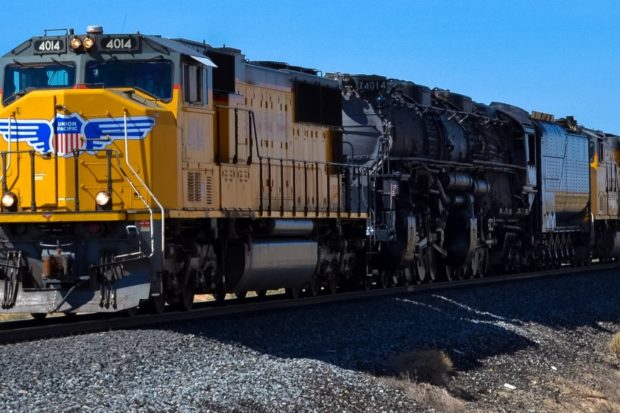
By Gary Lasky
Oil trains are rumbling through Fresno. They are dangerous, rolling time bombs. The U.S. Department of Transportation predicts 10 oil train derailments per year over the next decade. In the first quarter of 2015, there were five such fiery derailments in North America. In each case, firefighters were unprepared to extinguish the flames and let them burn for at least three days, spewing thick smoke and unknown toxic chemicals into the air.
“The oil train industry is playing Russian roulette with our communities,” said Valerie Love, No Tar Sands Campaigner with the Center for Biological Diversity. “Our water, air, climate and millions of Californians living next to oil train routes are at risk.”
This month, we commemorate the Lac-Mégantic oil train disaster. Lac- Mégantic is a small Quebec town close to the Maine border. On July 6, 2013, a train carrying flammable North Dakota Bakken crude oil ran downhill from where it had been parked by a train engineer for the night. With no lights, it picked up speed until, reaching a sharp turn, it jumped the tracks and derailed. At 1:15 a.m., on a sweltering night, local residents who had been enjoying themselves at a local bar felt what they thought was an earthquake. Some hid under tables. Others ran out the front door. It was no earthquake. Survivors described the fireball that overtook the bar patrons running for their lives. Forty-seven residents were killed and half of downtown Lac-Mégantic was incinerated.
According to Ethan Buckner, California oil train campaign organizer for ForestEthics, Fresno has two train routes, the Union Pacific and Santa Fe (BNSF), likely to carry oil trains. “Over 5 million Californians live within the 1-mile blast zone of an oil train, including in Fresno,” says Buckner.
Nobody is exactly sure where the oil trains run because the railroad companies refuse to divulge their locations or the contents of their loads. This is a problem, especially for firefighters faced with exploding cargo after the next derailment disaster. Oil trains have definitely been spotted downtown on the Union Pacific tracks.
These oil trains are headed to unload at two brand-new oil train terminals in Bakersfield. Built in 2014, the Plains All American and Alon oil train terminals were rushed into production to relieve the glut of fracked oil in North Dakota. Oil train traffic is up by 25 times in the past five years. Oil trains are everywhere, crisscrossing the states. Yet, without oil train terminals, the trains cannot unload their oil. Perhaps the urgency of this situation explains why one of the two Bakersfield oil terminals never received the required environmental review.
Fortunately, the Center for Biological Diversity, EarthJustice and the Sierra Club filed lawsuits against both of these Bakersfield oil train terminals. The cases are in court. One case is a CEQA (California Environmental Quality Act) lawsuit; the other got into court after attorneys discovered that the San Joaquin Air Pollution Control District had failed to review the air quality impacts of the proposed terminals.
I used to think that oil companies could strip the flammable components of the Bakken shale before it was shipped away. Not quite.
Not only is it difficult, expensive and energy-intensive to process shale rock into oil, it also requires the addition of “diluent” solvents. You heard that right: flammable chemicals are required to be added into the shale oil so that it can flow properly onto the rail cars. The same is true of Alberta tar sands oil. Conclusion: Oil trains are flammable by design.
Today, we know from scientists that we need to plan for a largely uninhabitable planet 80 years from now if we do not immediately cut our planetary emissions of carbon dioxide, methane and other contributors to climate change. Accordingly, the oil companies must leave in the ground, forever, 75%–80% of known fossil fuel reserves, or else risk our extinction. In his long-awaited encyclical last month, Pope Francis said that we must now take seriously such cataclysmic predictions of the impact of climate change.
Some oil reserves are worse than others.
Scientists evaluate oil fields in terms of the amount of energy and water required to extract, and process, specific fossil fuels into end products such as gasoline or natural gas. No surprise: Bakken shale oil and Canadian tar sands are among the least efficient, and most costly, of all North American petroleum products. Mining the Canadian tar sands involves the leveling of the great conifer forests and replacing them with huge piles of rubble. We’re talking here “bottom of the barrel” for American fossil fuel reserves.
What we need to do instead is to leave these fossil fuels in the ground— permanently.
Interestingly, some of the worst oil and gas reserves in the United States are right here in California— specifically, Fresno County’s Coalinga oil fields and the San Ardo formation in southern Monterey county. Oil from these formations is just as bad as the North Dakota and Alberta oil products in terms of energy required to extract it. Thick as mayonnaise, rich with sulfur and other impurities, this oil formerly could be used only as “bunker fuel” for offshore ships until a new refining process was developed in recent years.
On July 11 at 5 p.m., a nonviolent memorial protest will be held in downtown Fresno to commemorate the anniversary of the 2013 Lac-Mégantic oil train disaster. This action kicks off the oil train public awareness campaign by Fresnans Against Fracking.
For further information, contact Ron Martin at Fresnans Against Fracking at 559-222-5524 or martinrj93638@ yahoo.com.
*****
Gary Lasky is president of Fresnans Against Fracking and vice chair of the Sierra Club Tehipite Chapter in Fresno. He is presently planning to leave Fresno for law school somewhere in the West but promises to return to protect our San Joaquin Valley environment.
